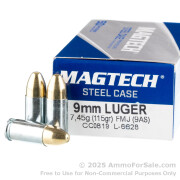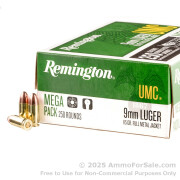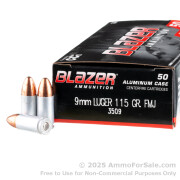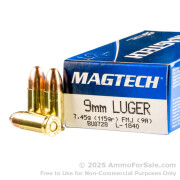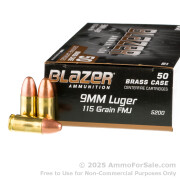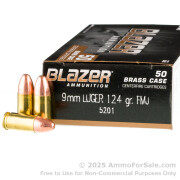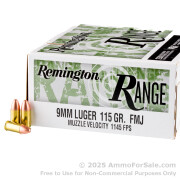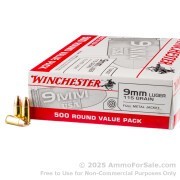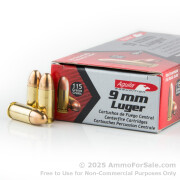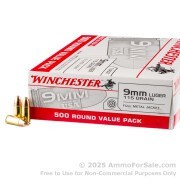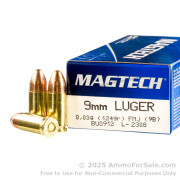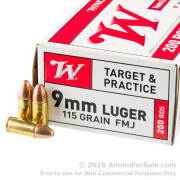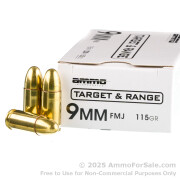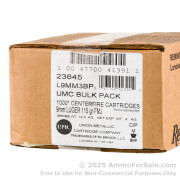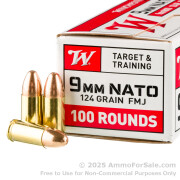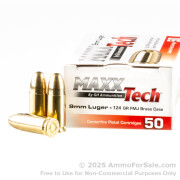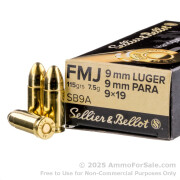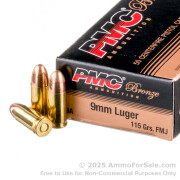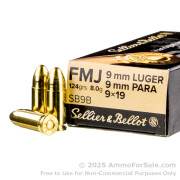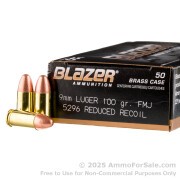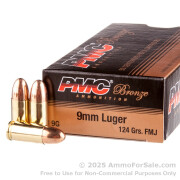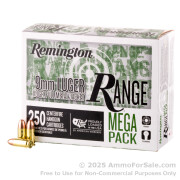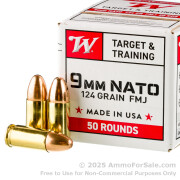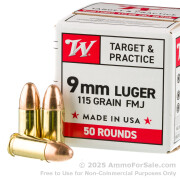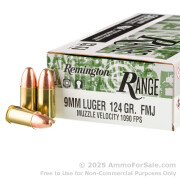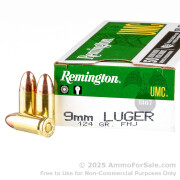9mm Ammo For Sale

The 9mm luger ammo cartridge, also known as the 9×19mm Parabellum, is the world’s most commonly used handgun cartridge. In fact, it is currently being used by more than 60 percent of the world’s police force. Thus, it is fairly easy to find 9mm ammo for sale and we're proud to offer 9mm rounds in bulk quantities in-stock for shooters to feed their guns!
The term Parabellum derives from the Latin phrase “if you seek peace, prepare for war.” The cartridge was created by Georg Luger and released for sale in 1902 for use with the DWM Luger semi-automatic pistol.
-
1000 Rounds of 124gr FMJ 9mm Ammo by Magtech *STEEL CASES*
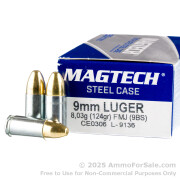
Regular Price: $209.95
Special Price: $194.95
22 ready to ship -
21 ready to ship
-
10 ready to ship
-
20 ready to ship
-
13 ready to ship
-
23 ready to ship
-
16 ready to ship
-
27 ready to ship
-
25 ready to ship
-
1000 Rounds of 115gr FMJ 9mm Ammo by Federal American Eagle
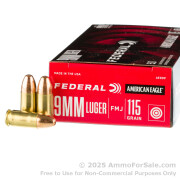
Regular Price: $269.99
Special Price: $234.95
26 ready to ship -
27 ready to ship
-
13 ready to ship
-
12 ready to ship
-
21 ready to ship
-
6 ready to ship
-
22 ready to ship
-
11 ready to ship
-
22 ready to ship
-
18 ready to ship
-
16 ready to ship
-
22 ready to ship
-
19 ready to ship
-
18 ready to ship
-
6 ready to ship
-
14 ready to ship
-
12 ready to ship
-
14 ready to ship
-
14 ready to ship
-
11 ready to ship
-
14 ready to ship
- Video

- Info
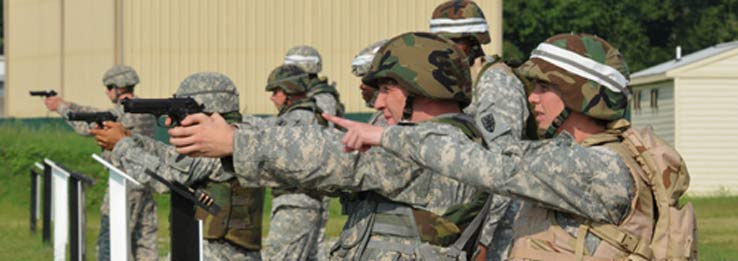
9x19 Ammo: What's So Awesome About It?
The 9mm luger ammo cartridge, also known as the 9×19mm Parabellum, is the world’s most commonly used handgun cartridge. In fact, it is currently being used by more than 60 percent of the world’s police force. Thus, it is fairly easy to find 9mm ammo for sale and we're proud to offer 9mm rounds in bulk quantities in-stock for shooters to feed their guns!
The term Parabellum derives from the Latin phrase “if you seek peace, prepare for war.” The cartridge was created by Georg Luger and released for sale in 1902 for use with the DWM Luger semi-automatic pistol.
The 9MM semi-automatic luger soon became the standard handgun for the German Navy and Army, and the prevalence of 9mm ammo for sale that followed is a testament to its capabilities as a field round. In 1955, NATO adopted the Parabellum as the standard sidearm cartridge. 30 years later, in 1985, the United States retired the .45 ACP and adopted the 9mm in Berreta 92 as the official United States Military cartridge. Although some people debated this decision, by the early 1990s, gun owners could find 9mm ammo for sale in nearly every gun shop in the country.
Since the cartridge is more compact, it is possible to carry more 9mm ammunition while decreasing the overall weight of the ammunition load. For this reason, many law enforcement agencies and private gun owners have swapped guns like the .38 Special and .357 Magnum for 9mm autoloaders, and it is easier to find 9mm ammo for sale in comparison to the aforementioned cartridges. Even the FBI adopted the 9mm Parabellum for a short period before switching to the newer 10mm cartridges.
Although the cartridge lacks the stopping power of a .45 ACP, it is often the best choice for the average shooter due to its compact, lightweight versatile nature. The 9mm Parabellum has been used in conflicts around the world, and it can even be used in hunting with the right equipment. For hunting, the modern JHP loads are optimal for performance improvement. JHP loads can be found in many of the same places where there is 9mmm ammo for sale, so if you’re planning on hunting with the gun, it would be best to purchase a JHP load.
While the 9mm Parabellum cartridge is not the most powerful in existence, 9mm ammunition allows for easier control, which is advantageous for more novice shooters that would not be able to handle a larger cartridge accurately. If you’re unsure about which cartridge would best accommodate your skill level, it may be best to speak with a qualified representative in an online shop where there is 9mm ammo for sale.
- Best
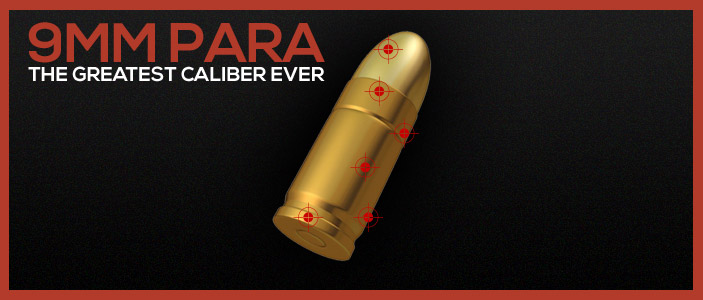
9mm is the Greatest Caliber Ever!
Shooters know what they like and seemingly every marksman has their own preference for which caliber is best. While it may be impossible to definitively say "9mm is the Greatest Caliber Ever!” it’s easy to make the case that it is and there are a number of reasons to feel that way, even if a logical person can make a case for just about any caliber.
We've assembled some of the most authoritative studies conducted, gathered the opinions of respected 9mm shooters, and as many other fact-based sources as possible to create this guide. While AmmoForSale.com certainly doesn’t intend to make the claim to have a solution for every shooter, we do believe you can make a case that each of the three primary handgun calibers could very well be best. In this article, we make the case for the most popular handgun caliber on the market today through eight distinct characteristics.
1. Capacity
I've never heard of a person who survived a shootout stating that ‘I wish I'd had less ammo on hand in that fight,’” Garry Hamilton, a long-time shooter and writer at Noisyroom.net said.

When you really need it, you'll be glad to have the extra rounds afforded by carrying a 9mm over larger pistols.
Whether you own a full-size 9mm pistol with the capacity to carry 18 rounds or a compact version that only carries closer to 10 rounds, odds are you’re going to have more chances to hit your target than if you carry a firearm chambered in .40 S&W or .45 automatic colt pistol.
Especially in high-adrenaline, self-defense situations, statistics show shooters aren’t as accurate as they might be under different, less threatening circumstances. Obviously, the more opportunities you give yourself to hit your target, the more likely you are to neutralize a threat or simply hit your mark.
It is simple, magazines afford you flexibility and additional rounds if you need them. While it's not hard to find a large 80-round drum magazine for just about any firearm these days, it's somewhat unrealistic to believe you'll be carrying a magazine that large in a true defense situation. After all, who can holster a drum magazine comfortably?
Is One Shot Enough?
“What I have concluded as a result of my research into how handguns are used for self-defense is this: the one-shot stop is relatively rare. Unless you hit a vital organ, such as the brain, spinal cord, or heart, no firearm that you can conceal is likely to cause immediate incapacitation,” Clayton Cramer, an Idaho-based shooter who writes at ClaytonCramer.com said.
A 2006 case investigated by the FBI’s ballistics team highlights a situation in which two officers exchanged more than 130 shots with an 18-year-old male assailant. In that situation, officers primarily fired 40 S&W rounds as well as .223 rifle rounds. Officers hit the assailant 17 times over a time period lasting just under 4-minutes.
After conducting an autopsy, the FBI determined six .40 S&W rounds entered the assailant during the gunfight. Five of those rounds were determined to have expanded properly inside him, yet police still had to fight with the assailant in order to get him handcuffed.
While it was obviously a stressful fight for the law enforcement officers involved, the results of the FBI’s report lend some insight to shooters interested in self-defense.
“Determined individuals can sustain many gunshot wounds in areas that produce great pain and continue to fight a long time, even without the aid of drugs or alcohol,” according to the Federal Bureau of Investigation’s Defensive Systems Unit and Ballistic Research Facility said.
So, to summarize: even after being shot six times, with five penetrating Speer 180 grain projectiles, the assailant was not neutralized and remained a threat, even as police slapped handcuffs on the perpetrator and took him into custody.
This scenario provides an excellent reminder about the importance of shot placement. No matter what the caliber, if you're not hitting your target in a vital area, it doesn't matter how large the potential wound cavity or how many shots you fire. Shot placement is king.
Yeah, But What about Stopping Power?
“There are a lot of folks out there with strong feelings about the issue of so-called 'handgun stopping power,' but I'm not one of them. I think it is almost entirely a myth, and think once you get to a certain minimal level of velocity and penetration (just for argument's sake, 22 magnum, or centerfires .32 and up), that the rest is merely a matter of shot placement and how bad the person who has been shot wants to keep fighting,” Bob Owens, a long-time shooting enthusiast, Appleseed Instructor, and writer at Bob-Owens.com said. “Beyond minimum levels required for penetration, I don't think caliber matters at all. Like in real estate, it’s all about location.”
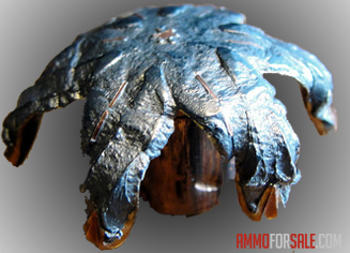
Winchester's Bonded PDX1 147 grain Ranger bullet fully expanded.
We’ll discuss 9mm's lethality and the idea of "stopping power" in greater detail later on in this guide. For now, consider this from Greg Ellifritz at Active Response Training.
Ellitfritz tracked shooting data over a 10-year period and found of the 456 individuals shot with a 9mm round in his sample size, the average target was incapacitated after 2.46 rounds. For larger calibers like .45 ACP, the average was still more than two rounds, 2.08 rounds.
Keep in mind, this data only takes into account the rounds that hit their intended target. Given the skill-level of the individual that carry each caliber of firearm, you could make assumptions based on the shooting skill-level of an average 9mm owner versus a .45 ACP owner.
Considering the initial investment to own each firearm as well as the average cost of ammunition, it seems reasonable the 9mm owner or shooter would likely have less time invested in training than the .45 ACP owner, since most .45 chambered firearms and ammunition is more expensive than their 9mm counterparts. Factors like non-vital hits seem more likely from the shooter with less range time under his or her belt. Additionally, from the police data Ellifritz analyzed, we don't know specifics about shots fired. It may have taken the 9mm and .45 ACP shooters the same number of rounds overall to actually bring down the target."If you overpower a new shooter before his or her confidence is ready, you run the risk of losing them," Leslie Appling, a Texas based shooter and author at The Lonely Libertarian said. "I prefer 9mm because it's my comfort zone. I do believe a shooter should be as familiar as possible with all calibers and as many different guns as possible in case he or she is in a situation needing to handle a strange gun. There's a very steep learning curve in an emergency."
Know Your Local Laws
For many shooters the logic is simple: more is more when it comes to capacity but that’s not always possible if you want to carry and be sure to follow the law of the state you’re in. In fact, the state you live in or spend most of your time carrying in can be a huge factor in deciding which caliber makes the most sense for you, assuming you want to stay within the law.
As you may have heard, there are certain state-restrictions you’ll want to keep in mind that can basically negate the capacity argument if you plan to follow the law. (For instance, New Yorkers are currently facing a lot of uncertainty because of the SAFE Act. Can they legally carry magazines with 10-rounds or are they limited to 7-rounds? If you want to follow the law, you might be maxed out at 7 rounds in New York, which negates some of the arguments in favor of 9mm because regulation has imposed a limit on your capacity.
2. Price Per Round
"The top level question is, 'What are you going to use this gun for? Recreation, self-defense, competition, all of the above?' Joe Huffman, a respected Idaho based shooter and author at The View North Central Idaho said. "Everything is a tradeoff. The smaller calibers tend toward higher capacities, higher velocities, lower costs, and, obviously, smaller holes… Once you figure out your application then the caliber question should pretty much answer itself."
If price is part of your equation, there is no denying 9mm is the most attractive of your mainstream options. In fact, a simple look around your favorite online ammunition retailer tells you everything you need to know about the price of 9mm rounds versus .40 S&W or .45 ACP.
Generally speaking, you can find plinking grade 9mm ammo for anywhere between 10 – 20 percent less than the price of .40 S&W or .45 ACP. For shooters serious about their skills, that means you get another 10 to 20 percent of the range time for your money compared to your colleagues who fire more expensive ammunition. We know the importance of shot placement and it’s clear that additional range-time could feasibly mean the difference between neutralizing an enemy with a shot on target or continuing to be in a dire situation, lobbing rounds toward your threat.
So just how big of a deal is the cost per round argument? Let’s say you have a $100 ammo budget per month and your goal is to get in as much range time as possible.
On $100 per month you can generally expect to buy about 400 rounds of medium-grade range-quality 9mm ammunition (at the retail price per round of $.26 to $.28 per round). For the same budget, you’d get about 100 rounds less of .45 ACP or .40 S&W.
Please note, ammo prices fluctuate based on the market and availability. The numbers in this graph suggest what most shooters would consider "normal" market conditions around the time of publication.Over time, the difference in range time is astounding.
Practice Makes Perfect
“I consistently shoot 9mm more quickly and accurately though I carry and can "qualify" with all the calibers for self-defense. I am a retired law enforcement officer and a highly experienced marksman who has been shooting regularly since 1976. But even for me, the 9mm is my "go to caliber" because I know I can perform best with it in all situations and circumstances. 15+1 will be more than enough when the rounds can be fired accurately,” Bonzer Wolf, a former White House Uniformed Officer, Special Agent with the Department of State, and writer at BonzerWolf.com said.
So how big of a deal is practice? Of course it varies based on the shooter but consider this test conducted by The University of Calgary and Minnesota State University using police officers in a simulated situation involving lethal force.
Researchers placed various law enforcement officers with varied levels of tactical experience in scenarios with an assailant. The officers’ shooting accuracy, decision making, and firing speed were all tested.
Those shooters identified as "experts" or "elite" officers hit the assailant with 75-percent of their shots fired, compared to just 54-percent of rookie officers.
Going one step farther, these tests found experienced officers fired faster and were more likely to land debilitating shots than their less-experienced peers.
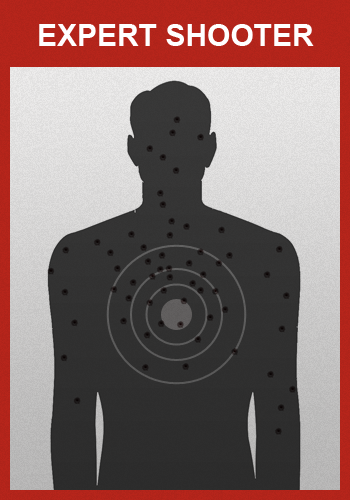
Expert shooters:
Upper Boxy/Torso - 62%
Arms/Hands - 31%
Legs - 7%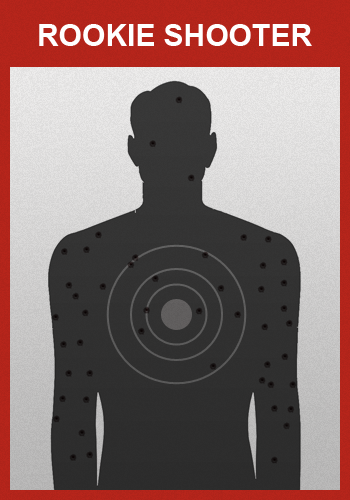
Rookie shooters:
Upper Boxy/Torso - 48%
Arms/Hands - 35%
Legs - 6%3. Ability to Conceal
“So, which is best, 9mm, .40 S&W, or .45 ACP? The answer is, the one you have with you when you need it,” Larry Card, a long-time shooting enthusiast and writer at Last Refuge of a Scoundrel said.
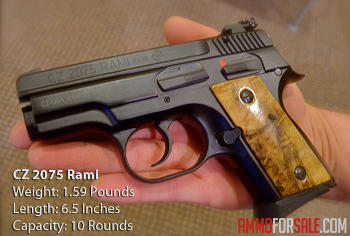
The CZ Rami is just one pocket pistol of dozens on the market today that are lightweight and easy to conceal.
When it comes to your ability to comfortably carry and conceal a firearm, it's true, you can find a compact .45 ACP that's about the size of a compact 9mm but you'll likely have a wider firearm to carry and controlling the .45 ACP with a subcompact frame may be much more difficult.
Consider the frame heights of the following popular concealed carry firearms. While you can certainly bump down to a 380 ACP or other smaller caliber, 9mm offers an attractive frame size compared to .45 ACP and other caliber pistols.
Height of the Firearm:45ACP:
Kahr PM45: 4.49 inches
Springfield XDS: 4.4 inches
Glock 36 Width: 4.76 inches9mm:
Beretta Nano: 4.17 inches
Sig Sauer P290: 3.90 inches
S&W Shield: 4.6 inches
Walther PPS: 4.4 inches4. Penetrating Power
While 9mm caliber firearms and ammunition cannot be 100% trusted to not over-penetrate a target and put others at risk, the chances of a 9mm round passing completely through a target are much lower than with more powerful rounds, especially with effective ammunition.
The FBI advises penetration of at least 12-inches is most desirable to ensure a shooter can hit vital organs deep inside a target’s torso. While some shooters will question the penetrating power of a 9mm round, there is very little to fear according to testing conducted by American Rifleman that you can see below:
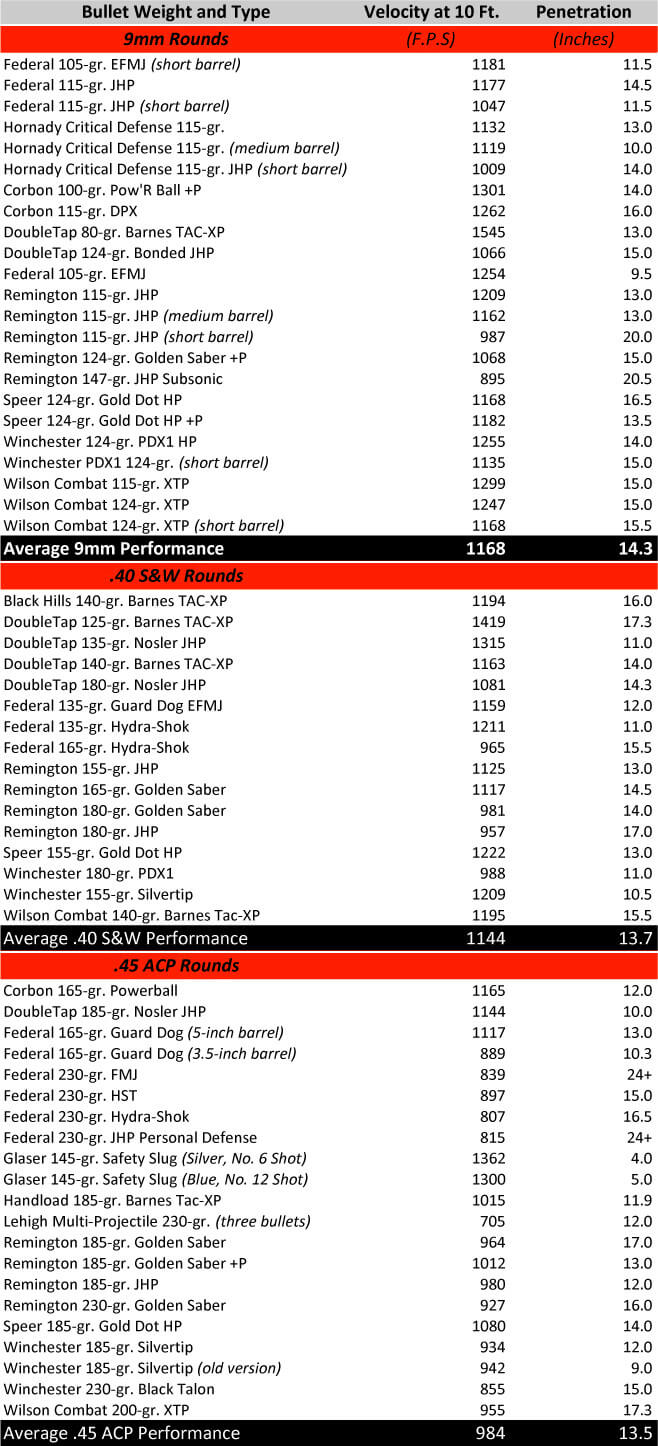
Perhaps more interesting than the raw penetration data is that the same test found .40 S&W didn’t have as much penetration power as 9mm. In fact of the dozens of different loads tested by the National Rifle Association Publication actually found a greater percentage of the .40 S&W rounds didn’t meet the FBI’s minimum penetration guidelines than the 9mm and .45 ACP counterparts.
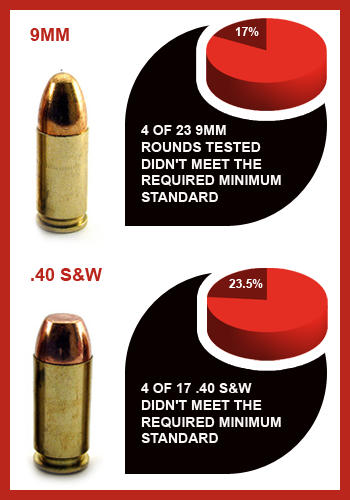
Penetration standard showing 4 of 23 didn't meet 12 inch minimum.
It should be also noted that bullet tracks can leave a temporary wound channel that is many, many times wider than the bullet, itself when going through tissue. So while even the expanded bullet can be visibly smaller in stature, ballistic technology has done a lot to help smaller cartridges, like 9mm rounds, inflict as much tissue damage as their larger and slower counterparts.
This data is especially interesting when you take into consideration that many experienced shooters consider the FBI standard 12-inches to be a conservative estimate when it comes to penetration. Duncan MacPherson, author of Bullet Penetration suggests that if you are required to fire through a target's arm or other extremity to get to vital organs, you might want your projectile to penetrate to a minimum of 14-inches instead.
When it comes to penetration the cartridges tested by American Rifleman in .45 ACP didn’t go as deep as 9mm. Despite a smaller projectile, the ballistic performance of 9mm ammunition penetrated deep enough and actually expanded well enough to be virtually indistinguishable from .45 ACP when wound channels were compared side-by-side.
However, ballistic tests aren't perfect and wound channels can be very different. For one, some wound channels that tear tissue are not long-lasting and generally referred to as temporary wound channels. This phenomenon causes the tissue to move temporarily but doesn't cause the same sort of permanent tissue tearing that a faster moving rifle projectile does.
5. Recoil Management & Accuracy
“I can get more shots on target, accurately, faster, with 9mm than the higher calibers, and while some may argue the higher caliber has more "impact" studies have been cited that the differences in wounding capacity between .38, 9mm, .40 and .45 are negligible,” Lynn Finch, a NRA Distinguished Expert in Pistol Marksmanship and author who writes at Female and Armed said.
Again, if you’re going to bring down an attacker right away, the best way to do it is to deliver a lethal shot to a target or attacker’s central nervous system in the brain or brain stem. In fact, the FBI found even if you put your rounds on an attacker’s circulatory system (the heart) and destroyed the organ, the threat may have enough oxygen in his or her brain to continue for up to 15-seconds. If armed, even a modestly trained assailant can get off an impressive number of rounds in that amount of time, as you can see in the video below:

Taking the argument one step farther, the concept of “stopping power” is one that is often brought up by proponents of larger handgun rounds. The laws of physics and ballistics research shows the idea of stopping power is often overestimated by recreational shooters and simply not a logical consideration when determining what caliber will best meet your needs.
“A bullet simply cannot knock a man down. If it had the energy to do so, then equal energy would be applied against the shooter and he too would be knocked down. This is simple physics, and has been known for hundreds of years,” Stanley Goddard of Battelle Labs once presented to the FBI Academy.
Goddard amply proves the fallacy of "knock-down power" by calculating the heights (and resultant velocities) from which a one pound weight and a ten pound weight must be dropped to equal the momentum of 9mm and .45 ACP projectiles at muzzle velocities, respectively. The results are revealing.
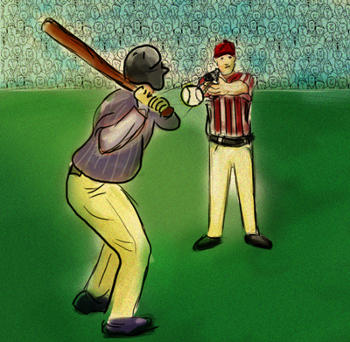
Purely from a physics perspective, the energy delivered to a target by a bullet is similar to that of a baseball being thrown by a pitcher.
In order to equal the impact of a 9mm bullet at its muzzle velocity, a one pound weight must be dropped from a height of 5.96 feet, achieving a velocity of 19.6 feet per second (fps). To equal the impact of a .45 ACP bullet, the one pound weight needs a velocity of 27.1 fps and must be dropped from a height of 11.4 feet. A ten pound weight equals the impact of a 9mm bullet when dropped from a height of 0.72 inches (velocity attained is 1.96 fps), and equals the impact of a .45 when dropped from 1.37 inches (achieving a velocity of 2.71 fps).
Another study published in the International Journal of Legal Medicine suggests a case where a man dressed head-to-toe in body armor is shot twice with a 7.62 mm NATO rifle. In the trial, the man doesn’t move after being shot. Making the situation even more comical, the test subject stands on one-foot and is not even knocked off balance by one of the rifle projectiles.
In Lehman’s terms, while a projectile from a firearm is certainly more lethal because of the blood loss that can occur from the wound channel, in terms of physics, the energy deposited into a target’s body by a bullet is about the same as if they were hit by a baseball thrown by a major league pitcher, not exactly the result we see based on Hollywood portrayals, is it?
6. Military Use
When the powerful and sizeable United States military selects a caliber, you have a pretty good idea about two things:
- 1. The round is mostly reliable – although some may debate this characteristic.
- 2. Manufacturers are likely to be make a lot of that caliber of ammunition for a long time.
The United States military adopted the Beretta 9mm as the standard issue pistol for servicemen and women in 1990. At the time of adoption, durability was a critical characteristic that led to the military’s selection of 9mm. Currently, Beretta is producing 9mm weapons for the military under a contract that doesn’t expire until 2015. That kind of stability promises shooters that 9mm ammunition will continue to be mass produced until at least that year.
With the 9mm ammo in use by nations all over the world, in the event of an apocalyptic situation your odds of finding additional ammunition for 9mm seem as good, if not better, than any other round manufactured today.
The military issues millions of rounds ball ammunition to servicemen and women so you know the nation's infrastructure is in place to produce a somewhat steady stream of these cheap, effective range rounds for many years to come. That’s good news if you’re planning to actually shoot your gun and not just keep it in a drawer in case the zombies knock at your bedroom door someday.
“So far I have not seen anyone walk away from a solid hit with a 9mm to the central nervous system, and if you miss the CNS then putting multiple holes into the attacker is probably your best bet (I'll let you do the math on the volume of blood you can spill out of eight .45 ACP holes, 13 .40 S&W holes, and 17 9mm holes, the answer may surprise you),” James Armstrong, a soldier and shooter who writes at Random Thoughts and Guns said.
7. Speed Of Shots
“When hitting counts, the best round for you is the one you shoot best. For me, the one I shoot best is the 9mm,” Garry Hamilton said.
You’ll often hear .45 ACP supporters claim the recoil in their .45’s is about the same as in their 9mm pistols. While it can vary based on firearm, ammunition, and other factors, under similar conditions 9mm shooters almost always enjoy lower recoil energy than shooters of .40 S&W or .45 ACP according to data compiled by Chuck Hawks with the help of the Lyman Reloading Handbook.
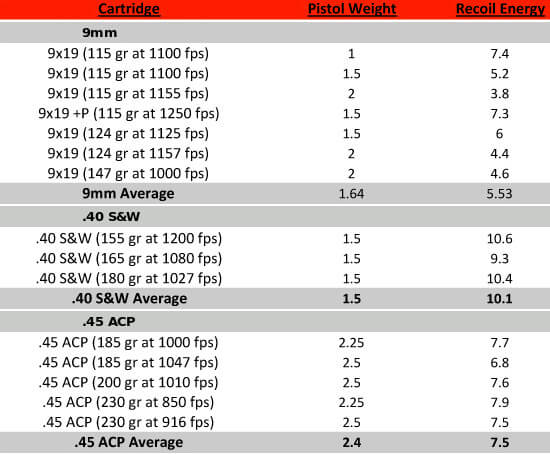
Thanks to lower recoil than the .40 S&W and .45 ACP, the argument is also frequently made that 9mm shooters are able to fire more rounds on target faster than shooters using larger, more powerful handguns.
8. Lethality/Power/”Stopping Power”
“There are now excellent options for defensive loads in 9mm which, in my mind, negate the argument that it lacks stopping power. As for which is "better," that's a flame war I'd rather not start, but based on recoil, capacity, and price, 9mm Luger strikes the right balance,” Lloyd Bailey, a shooting sport enthusiast, NRA member, and writer at The Armed Lutheran said.
Anecdotal evidence from shooters discussing the virtues of 9mm as it relates to lethality and stopping power are not hard to find. However, a much more rigorous scientific analysis of handgun rounds known as the Strasbourg Tests found that there is a very low probability of firing one-shot and achieving incapacitation of your target.
Joe Huffman suggests Greg Hamilton may have said it best:
“The entire discussion of “stopping power” is both stupid and irrelevant. Statistics cannot be applied to individuals. People that need to be shot need to be shot soon and often. They need to be shot until they run out of fluid, brains, or balls.”
Still not convinced? Consider this other bit of data from Greg Ellifritz's previously mentioned decade-long study:
Of 456 shootings involving 9mm ammunition, 13% were not incapacitated. Of the 209 people shot with .45 ACP in his study, 14% were not incapacitated.
The Strasbourg Tests
“More is always better; and since modern service ammo in 9mm, .40 S&W and .45 ACP is all designed to perform to the same standard, why carry fewer rounds? Get literally more bang for your buck,” Caleb Giddings, a competitive shooter, former Top Shot contestant and owner of Gun Nuts Media said.
The evidence doesn’t stop at the FBI’s analysis when it comes to the amount of firepower you can reasonably expect to use in a self-defense scenario.
In the early 90’s, a team consisting of surgeons, a veterinarian, medic, and other personnel fired rounds into more than 600 French Alpine goats as part of what are now known as The Strasbourg Tests.
In these tests, researchers used adult male goats that weighed about 150 pounds. These animals were selected because they generally have rib cage dimensions similar to what you’d find in an adult human male.

A male French Alpine goat standing in the French countryside. Lucky for this guy, he wasn't part of The Strasbourg Tests.
Researchers found the most effective ammunition fragmented or immediately expanded upon impact. But perhaps more importantly, the test concluded no single handgun round can be counted on to immediately incapacitate any person. The research team detailed multiple examples of goats kicking, running, and even attempting to eat after being shot with several of the handgun rounds.
The anonymity of the research team has led some to discredit these alleged tests. For one, an FBI committee concluded that the test may be a fraud. Critics of the alleged tests asked “Why would experimental results be circulated anonymously?”
Still other scholars suggest anonymity alone is not reason enough to disqualify the results and tests conducted since The Strasbourg Tests have produced results similar to the trials.
Still, it is possible the concept of "stopping power" is still too abstract. It may be easier to tackle it from a different angle. Take, for instance, a modern broadhead hunting arrow. It’s incredibly lethal when used properly but only delivers about 50-foot-pounds of kinetic energy upon impact. That’s less than a .22 short projectile. Purely from a physics and force perspective, the arrow is relatively weak. However, when allowed to create penetration and a wound channel, the broad-headed tip is lethal.
“In reality, the kinetic energy transfer fallacy is a smokescreen that hides the actual ways in which the projectile interacts with tissue,” Craig Lawrence of URI Training said. “Many body tissues (muscle, skin, bowel wall, lung) are soft and flexible --- the physical characteristics of a good shock absorber.”
Conclusion
“The main reason for debates about what caliber is best is based upon false information. Many shooters ‘believe’ that one caliber is better than others, but they are simply mistaken. With the “best ammunition” all major calibers are basically the same. Therefore, I would look to the 9mm, as it will have the highest ammo count per magazine,” Don, a certified pistol instructor and personal firearms defense instructor who writes at The Box O' Truth said.
As you probably have observed, shooters love to discuss the finer points of shooting and one of the most hotly debated topics of all time has got to be which caliber is the best. Of course, you can make a case for just about every caliber in the right scenario or situation.
Now that you’ve read the case for 9mm, what do you think? Sound off in the comments below and be sure to take a look at the graphic summary!


 Loading, please wait...
Loading, please wait... 